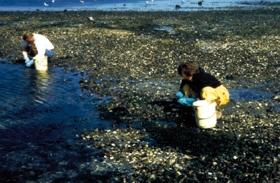NIST Intercomparison Exercise Program for Organic Contaminants in the Marine Environment
Summary
Since the beginning of the National Oceanic and Atmospheric Administration (NOAA) National Status and Trends (NS&T) Program in 1987, NIST has coordinated intercomparison exercises for the determination of organic contaminants in marine sediment and tissue as part of the NS&T quality assurance (QA) program. National Research Council (NRC) of Canada has coordinated similar intercomparison exercises for trace elements. These intercomparison exercises have become an excellent tool for assessing the comparability of analytical measurements among the marine environmental measurement community.
Description

Photo showing two NIST staff collecting samples along a shoreline.
Until 2000, these intercomparison exercises were carried out with financial support from both NOAA and NIST. Beginning in 1993, laboratories not directly involved with NOAA programs (e.g., private laboratories) were allowed to participate in the exercises by paying a participation fee. Since 2000, NIST has required all laboratories participating in the organic exercises to pay the participation fee, which partially covers the costs of the program.
Major Accomplishments
NISTIR 7501: NIST Intercomparison Exercise Program for Organic Contaminants in the Marine Environment: Description and Results of 2007 Organic Intercomparison Exercises
NISTIR 7340: NIST Intercomparison Exercise Program for Organic Contaminants in the Marine Environment: Description and Results of 2005 Organic Intercomparison Exercises
NISTIR 7792: Interlaboratory Analytical Comparison Study to Support Deepwater Horizon Natural Resource Damage Assessment: Description and Results for Marine Sediment QA10SED01
NISTIR 7793: Interlaboratory Analytical Comparison Study to Support Deepwater Horizon Natural Resource Damage Assessment: Description and Results for Crude Oil QA10OIL01
NISTIR 7819: Interlaboratory Analytical Comparison Study to Support Deepwater Horizon Natural Resource Damage Assessment: Description and Results for Mussel Tissue QA10TIS01
Additional Technical Details
A list of target analytes in the NIST Intercomparison Exercise Program for Organic Contaminants in the Marine Environment is provided.
Marine Sediment XIV QA07SED14 3 x 21.0 g (wet-mass basis) of a wet marine sediment (Each sample was prepared by adding a known mass of water to a known mass of marine sediment that was collected in a harbor area and has been freeze-dried, ground, sieved, and radiation-sterilized. This material is stored at -20 °C until shipped to participants on dry ice.)
Mussel Tissue XIII QA07TIS13 2 x 6 g (dry-mass basis) of a freeze-dried mussel tissue homogenate (The mussels were collected from an urban area. It was prepared as a cryogenically homogenized, fresh material and then freeze-dried in bulk. The freeze-dried material was sieved to remove the larger particles. This material is stored at room temperature.)
CONTACT INFORMATION
If you are interested in the inorganic intercomparison exercise, please contact Scott Willie at the Institute for National Measurement Standards, National Research Council of Canada, Ottawa, Ontario, Canada K1A OR6; Telephone 1-613-993-4969; Fax 1-613-993-2451; e-mail scott.willie [at] nrc.ca (scott[dot]willie[at]nrc[dot]ca).

